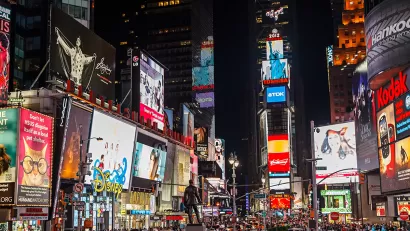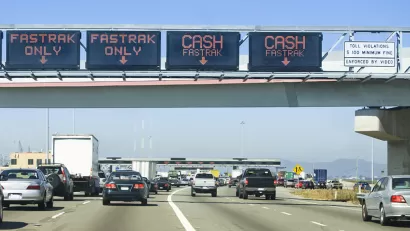The Daily Source of Urban Planning News
The McMansion Strikes Back: New American Homes are Larger than Ever
According to new date from the U.S. Census, McMansions are back. In fact, the data indicates that the housing crash and recession was a temporary pause in the long-term trend of the always-expanding American home.
California Water Suppliers Respond to Drought and Climate Change
Jeff Kightlinger, General Manager of the Metropolitan Water District of Southern California, details the ongoing preparation and response his regional water agency has championed in the face of the driest calendar year in the state's history.
Meet Boston's New Tech-Enabled 'Pop-Up' Bus Service
A private bus service launched this week in Boston that decides service based on crowdsourced data on where and when people need to travel.

Lessons from Philadelphia's Newest Pedestrian Plaza
Convincing neighborhood stakeholders and local businesses that shutting down a street to cars is a good idea can be a herculean task. After nine years of work to do just that, a group of advocates in Philadelphia has lessons to share.
Joel Kotkin Reveals the Secrets of Cleveland's Surprising Success
Joel Kotkin picks up on the findings of a study released in March from Cleveland State University about the city's net increase in young, well-educated population and recommends a regional approach to ensuring that the growth sticks.

Friday Funny: The Signage of the Not-So-Distant Future
A Tumblr called Signs from the Near Future has seen the signs, and has predicted what the signs of the future will look like.

Op-Ed: User Fees, Not General Funds, Should Fund Transportation
The Washington Post editorializes against the use of general funds to fill the Highway Trust Fund shortfall ($18 billion annually), whether they be dedicated funds or offsets, and evaluates proposals from President Barack Obama and House Republicans.

The New Transportation Mode of Choice for Urban Professionals: Skateboards
Although the skateboard's been around for a while, recent modifications to traditional designs are targeting skateboards for an older, wealthier demographic.
How Much Carbon Will Your State Cut under the EPA's New Rule?
A state-by-state breakdown of the U.S. Environmental Protection Agency's proposed carbon reduction rule reveals that some states will have to go far beyond the 30 percent goals for the country overall.
How to Build Grassroots Support for Urbanism
Andrew Keatts interviews Benjamin Ross, of Maryland's Purple Line advocacy fame, about what it takes to build local support for transit and urban design.
Minneapolis Restaurants Push Back on '70/30' Food-to-Alcohol Rule
All over the country, local craft brews, and the restaurants that serve them, have been drivers of economic development and neighborhood revitalization. But a restrictive law in Minneapolis has prevented the full benefit of the industry.
Could Viable Transportation Options End Drunk Driving?
A recent article by Sommer Mathis fills a void in supportive arguments for alternative forms of transportation: giving people more and better options not to drive, especially while drunk, is a massive public safety issue.

Should Preservationists Leave Space for Parking Lots?
Here's one you probably didn't see coming. A recent pair of articles makes the case for preservationists to find ways to protect surface parking lots.
Rainwater Capture as a Game Changer for Drought-Prone Cities
During Australia's 12-year drought, cities like Brisbane cut water usage per-person-per-day by more than half. Andy Lipkis, the founder and president of TreePeople, believes Los Angeles can follow this example.
Chicago Lighting Proposal Would Turn the Wattage Up
As part of an initiative called Choose Chicago, meant to boost the city's draw for tourists, Mayor Rahm Emanuel is pursuing a plan to light the city up

What Urban Planners Fail to Grasp in Climate Action Plans
Climate mitigation and adaptation have become de rigeur aspects of urban planning for most cities, according to results from MIT's international Urban Climate Change Governance Survey. What's missing in most plans is the link to economic development.

FEATURE
Did Google Find a Low-Speed Shortcut to Fully Automated Vehicles?
Google's bold new design for a self-driving car has no steering wheel or pedals. And it has a top speed of 40 km/h. Here is a look at Google’s plans and the role low-speed automated vehicles could play in urban transportation.
MoveDC Long Range Transportation Plan Available for Public Comment
The Washington Post has a look at the initial draft of MoveDC, Washington D.C.'s Multimodal Long Range Transportation Plan, which will guide the city's transportation plans until 2040. The plan is available for public comment until July 6, 2014.
Big Plans for Garden Cities in the United Kingdom
Garden cities have been making news lately thanks to a new book by architect Robert A.M. Stern, but a design competition and policy declarations in the United Kingdom have put some serious skin in the game.
San Francisco Approves Prop B Height Restrictions
The eventuality predicted since San Francisco's Prop. B qualified for the ballot has come to pass, with more than 59 percent of San Francisco voters approving the ordinance that will require votes on developments exceeding existing height limits.
Pagination
City of Moorpark
City of Tustin
Tyler Technologies
City of Camden Redevelopment Agency
City of Astoria
Transportation Research & Education Center (TREC) at Portland State University
Regional Transportation Commission of Southern Nevada
Toledo-Lucas County Plan Commissions
Urban Design for Planners 1: Software Tools
This six-course series explores essential urban design concepts using open source software and equips planners with the tools they need to participate fully in the urban design process.
Planning for Universal Design
Learn the tools for implementing Universal Design in planning regulations.


































